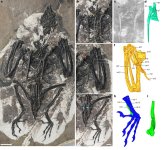Fred Ruhe
Well-known member

Zhiheng Li, Min Wang, Thomas A. Stidham & Zhonghe Zhou, 2023
Decoupling the skull and skeleton in a Cretaceous bird with unique appendicular morphologies
Nature Ecology and Evolution 1-12
doi:10.1038/s41559-022-01921-w
Abstract: Bird Paleontology
The Cretaceous is a critical time interval that encompasses explosive diversifications of terrestrial vertebrates, particularly the period when the earliest-branching birds, after divergence from their theropod ancestors, evolved the characteristic avian Bauplan that led eventually to their global radiation. This early phylogenetic diversity is overwhelmed by the Ornithothoraces, consisting of the Enantiornithes and Ornithuromorpha, whose members evolved key derived features of crown birds. This disparity consequently circumscribes a large morphological gap between these derived clades and the oldest bird Archaeopteryx. The non-ornithothoracine pygostylians, with an intermediate phylogenetic position, are key to deciphering those evolutionary transformations, but progress in their study has been hampered by the limited diversity of known fossils. Here we report an Early Cetaceous non-ornithothoracine pygostylian, Cratonavis zhui gen. et sp. nov., that exhibits a unique combination of a non-avialan dinosaurian akinetic skull with an avialan post-cranial skeleton, revealing the key role of evolutionary mosaicism in early bird diversification. The unusually elongated scapular and metatarsal one preserved in Cratonavis highlights a breadth of skeletal plasticity, stemming from their distinct developmental modules and selection for possibly raptorial behaviour. Mapped changes in these two elements across theropod phylogeny demonstrate clade-specific evolutionary lability.
Enjoy,
Fred
Decoupling the skull and skeleton in a Cretaceous bird with unique appendicular morphologies
Nature Ecology and Evolution 1-12
doi:10.1038/s41559-022-01921-w
Abstract: Bird Paleontology
The Cretaceous is a critical time interval that encompasses explosive diversifications of terrestrial vertebrates, particularly the period when the earliest-branching birds, after divergence from their theropod ancestors, evolved the characteristic avian Bauplan that led eventually to their global radiation. This early phylogenetic diversity is overwhelmed by the Ornithothoraces, consisting of the Enantiornithes and Ornithuromorpha, whose members evolved key derived features of crown birds. This disparity consequently circumscribes a large morphological gap between these derived clades and the oldest bird Archaeopteryx. The non-ornithothoracine pygostylians, with an intermediate phylogenetic position, are key to deciphering those evolutionary transformations, but progress in their study has been hampered by the limited diversity of known fossils. Here we report an Early Cetaceous non-ornithothoracine pygostylian, Cratonavis zhui gen. et sp. nov., that exhibits a unique combination of a non-avialan dinosaurian akinetic skull with an avialan post-cranial skeleton, revealing the key role of evolutionary mosaicism in early bird diversification. The unusually elongated scapular and metatarsal one preserved in Cratonavis highlights a breadth of skeletal plasticity, stemming from their distinct developmental modules and selection for possibly raptorial behaviour. Mapped changes in these two elements across theropod phylogeny demonstrate clade-specific evolutionary lability.
Enjoy,
Fred




